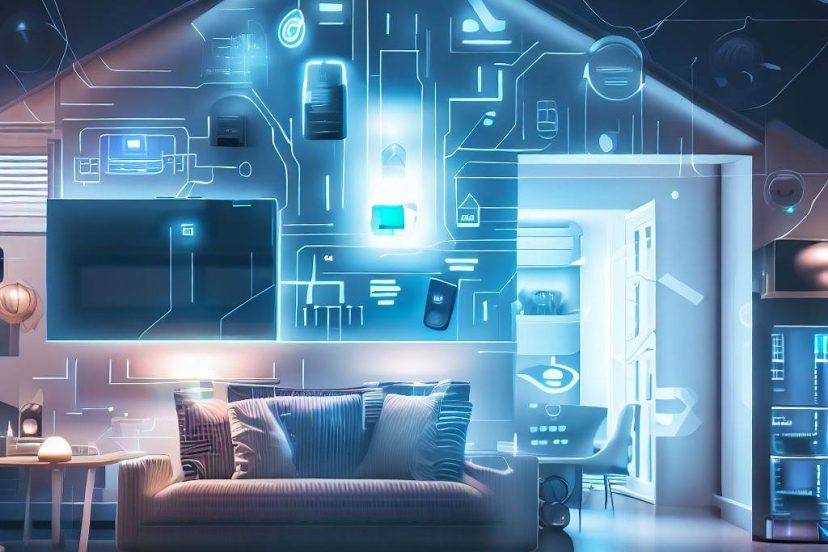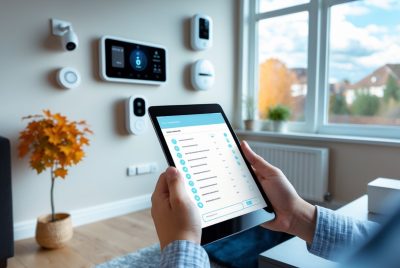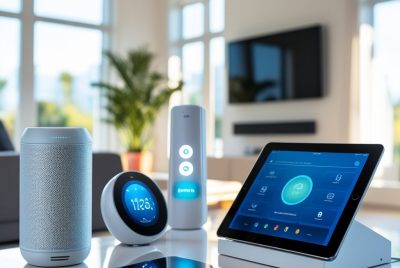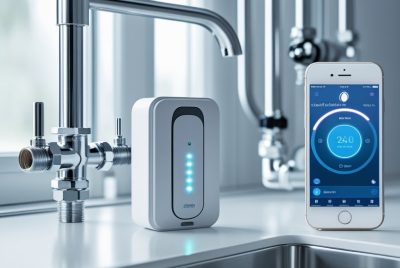Home Automations: A Modern Living Guide
*We may earn a commission for purchases made using our links. Please see our disclosure to learn more.
Home Automations Essentials: Boosting Your Living Space with Smart Technology
In recent years, I’ve observed that home automations have cemented itself as a cornerstone of modern living. Essentially, it’s the application of technology to automate household activities and functions, creating an ecosystem where devices and appliances can communicate with each other to enhance convenience, efficiency, and security. Through a network of interconnected devices, from lighting and heating to entertainment systems, I can now control almost every aspect of my home environment remotely or via a central hub.

With advancements in artificial intelligence and the Internet of Things (IoT), I find that smart homes have evolved significantly. Devices are smarter and more capable of understanding my needs and preferences. They can learn from my habits and adjust settings to save energy or provide comfort without my input. This level of automation not only adds to the comfort of my daily life but also enhances home security and helps manage energy consumption more efficiently.
The integration of various protocols and standards, like Zigbee, Z-Wave, and the emerging Matter, ensures that these smart devices can seamlessly communicate and work together. Open-source platforms like Home Assistant give me, and others who have a knack for tinkering, the ability to tailor our home automation systems to our exact specifications and preferences. At the same time, out-of-the-box solutions from Amazon Echo or Google’s ecosystem provide an accessible entry point into home automation for those who prefer a ready-made setup. Through these technologies, I can enjoy a more connected and responsive home environment.
The Essentials of Home Automations

Home automation integrates technology into the personal home to provide ease, comfort, and efficiency. I’ll explain the basics and the key components that make up smart homes.
Understanding the Basics of Home Automations
At its core, home automation is about using technology to automate daily tasks in the home. This concept is an integral part of the Internet of Things (IoT), where devices are interconnected and communicate over the internet. Automation in homes facilitates the remote control and management of appliances and systems, ranging from simple tasks like turning lights on and off to more complex scenarios like security monitoring.
Key Components of Smart Homes
- Smart Devices: The building blocks of any automated home, smart devices vary widely, including light bulbs, thermostats, cameras, and locks.
- Control: Control mechanisms allow me to interact with smart devices. This can be done through voice commands, apps, or even smart hubs.
Here’s a simplified breakdown of the key components:
| Component | Function |
| Smart Hub | Central point of control for smart devices |
| Smartphone App | Interface for monitoring and controlling the system |
| Smart Devices | Appliances and systems that perform automated tasks |
Smart hubs act as the brain of the home, orchestrating the behavior of all connected smart devices. With a smartphone app, I can receive feedback and issue commands, even when I’m not physically home. Technology brings all these elements together under the umbrella of the IoT, paving a path toward a truly automated and connected living environment.
Smart Control and Connectivity with Home Automations

In my overview of smart home automation, control and connectivity emerges as a crucial aspect. Proper integration ensures seamless operation while communication protocols guarantee devices speak the same language.
Communication Protocols
My experience tells me that communication protocols are the backbone of smart home technology. There are several dominant players in this field:
- Wi-Fi: Ubiquitous and powerful, it’s great for high-bandwidth devices but can be energy-intensive.
- Zigbee and Z-Wave: These mesh network protocols are energy-efficient, though Z-Wave operates at a lower frequency, which can mean fewer interferences.
- Bluetooth: Ideal for low-energy, close-range communication, but limited by distance.
- Matter (formerly Project CHIP): It’s a new industry-standard promising universal compatibility and secure connectivity.
Given these protocols, choosing the right one is contingent upon the specific needs of the smart devices and their intended uses within the home network.
Integration and Compatibility
It’s essential to ensure that different smart devices can work together seamlessly. This is where:
- Compatibility: Devices must share compatible protocols. For example, a Zigbee smart lock might not directly communicate with a Wi-Fi-based smart speaker unless a compatible hub is involved.
- Platforms: Automation powerhouses like Amazon Echo or Google Home act as central control points for various devices, bringing disparate protocols under one roof, thanks to their multi-protocol support.
- Networking: Connectivity depends on a stable network. I recommend using devices that can handle potential networking issues to maintain strong automation functionality.
As an industry expert, I emphasize the significance of choosing devices that support these protocols and platforms to ensure a robust and flexible smart home network.
Home Automations Devices and Systems

In the realm of home automation, three systems stand out for their ability to enhance convenience, safety, and efficiency: smart lighting, security and monitoring, and climate control. They incorporate a variety of devices like sensors, smart locks, and thermostats to streamline the daily operation of a home.
Smart Lighting
Smart lighting systems, including smart lights and light sensors, allow me to automate the illumination of my home. I can schedule lights to turn on and off at specific times or control them remotely via a smartphone app. For example, Philips Hue bulbs can change colors and brightness, while Lutron’s dimmer switches save energy without needing a smart bulb.
- Lights: Schedule on/off times; remotely control brightness/color
- Sensors: Activate lights based on motion or ambient light
Security and Monitoring
For security, smart cameras, door locks, and garage door sensors ensure the safety of my property. These devices can be monitored and managed from anywhere, giving me peace of mind. I can check the live feed from a Nest Cam or receive notifications if my August Smart Lock is tampered with. Additionally, integrating sensors around my home provides instant alerts to potential security breaches.
- Cameras: Watch live feeds, receive motion alerts
- Locks: Remotely manage access, receive lock/unlock notifications
- Garage Door: Monitor and control the garage door remotely
Climate Control and Energy Savings
Lastly, climate control uses smart thermostats and energy monitors to optimize heating and cooling, leading to substantial energy savings. Devices like the Ecobee SmartThermostat or Nest Learning Thermostat adjust temperatures based on my habits and presence. Smart plugs can turn off stand-by power to non-essential devices, while energy monitors provide insights on energy consumption.
- Thermostats: Auto-adjust temperatures; learn user habits for efficiency
- Energy Monitor: Track and optimize home energy usage
- Smart Plugs: Control non-essential devices to save energy
Home Automations: Setup and Control Interfaces

Controlling a smart home can be broken down into Standalone versus Centralized systems, each with their distinct means of setup and interaction. I’ll also discuss the ever-growing popularity of voice and mobile controls, which have become integral to the modern smart home experience.
Standalone vs Centralized Control
Standalone systems allow me to control individual devices directly, often via their own dedicated remotes or built-in interfaces. For instance, a smart light might come with its own remote control, allowing me to adjust brightness or color temperature directly.
In contrast, centralized control systems consolidate the management of various smart home devices into a single interface, which can be a dedicated hub like the Wink Hub 2 or a software platform like Home Assistant. This approach has several advantages:
- Convenience: I manage all devices through one dashboard.
- Integration: Devices from different manufacturers can work seamlessly together.
- Scenes and Automation: I can create complex interactions between devices.
Voice Command and Mobile Control
Voice assistants such as Google Assistant, Amazon Alexa, and Siri have revolutionized the way I interact with my smart home by enabling voice commands. Here’s a straightforward comparison:
- Google Assistant and Amazon Alexa are widely supported and can handle a diverse array of voice commands.
- Siri is ideal for those invested in the Apple ecosystem, prioritizing data privacy and security.
Moreover, smartphones have become central to home automation systems via mobile apps. These apps allow me to:
- Remotely: Control my smart home devices from anywhere.
- Customize: Set up personalized routines and schedules.
- Monitor: Receive notifications and check the status of devices.
The integration of voice assistants and mobile apps has made controlling my smart home more intuitive and accessible, even when I’m not physically present.
Brands and Ecosystems for Home Automations

In this section, I’ll explore the notable brands and ecosystems that define the home automation landscape. My focus will be on major players and their offerings as well as what to consider when evaluating different ecosystems.
Major Players and Offerings for Home Automations
The home automation market is dominated by several key players, each with their own unique offerings:
- Amazon: With the Amazon Echo and the Alexa app, users gain a voice-controlled hub that interfaces with numerous smart devices. Amazon’s ecosystem is highly intuitive and user-friendly, making it a top choice for many.
- Google: Google offers the Google Nest Hub and a range of related products that integrate seamlessly with the Google Assistant. This ecosystem is becoming increasingly popular due to its deep integration with Google’s services.
- Apple: Apple HomeKit is designed for those invested in the Apple ecosystem, offering superior data privacy and security. Their products, like the HomePod, work very well within the Apple IoS environment.
- Samsung SmartThings: Ideal for a diverse and customizable experience, Samsung SmartThings provides users with a flexible platform that’s compatible with a wide range of devices.
Other noteworthy platforms include:
- Philips Hue: Known for their smart lighting, Philips Hue is widely adopted for its user-friendly and robust integration capabilities.
- Vivint: Catering to security-focused smart homes, Vivint offers a comprehensive system that includes 24/7 monitoring.
Evaluating Different Ecosystems
When assessing different home automation ecosystems, consider the following:
- Compatibility: Look at the range of compatible devices and brands. The most versatile systems, such as Amazon Alexa and Google Nest Hub, support a multitude of products.
- Security and Privacy: Evaluate the security measures and privacy policies of each platform. Apple HomeKit is well-regarded in this aspect.
- Ecosystem Integration: How well does the system integrate with existing devices and services? IoS users may find Apple HomeKit to be the most cohesive choice, while users of multiple operating systems might lean towards Google or Amazon.
- User Experience: Consider ease of use from setup to daily operation. Amazon Echo and Alexa App are acclaimed for their user-friendly design.
- Cost: Factor in the initial investment and potential ongoing costs. Some systems, like Samsung SmartThings, offer greater customization, which can be cost-effective in the long run.
By understanding these key aspects, you can select the home automation ecosystem that best suits your specific needs and preferences.
Frequently Asked Questions
In this section, I’ll address some of the top inquiries about home automation, covering its innovative applications, energy efficiency, security benefits, essential devices for beginners, factors in system selection, and the integration of voice-controlled devices.
1. What are the most innovative home automation ideas currently being implemented?
Innovative home automation ideas include smart fridges that can track expiration dates, voice-controlled showers, and automated pet feeders. Developers are also exploring the integration of artificial intelligence to predict resident behaviors and adjust settings for comfort and efficiency.
2. How can home automation improve energy efficiency in a household?
Home automation significantly enhances energy efficiency by allowing precise control over heating, cooling, and lighting schedules. Smart thermostats learn your routine and adjust temperatures accordingly to reduce waste, while connected lights can automatically turn off when no one is in the room.
3. What security benefits can be gained from integrating home automation systems?
Integrating home automation provides real-time alerts and remote monitoring options that increase home security. For instance, homeowners can receive instant notifications for unusual activities, view security camera footage via smartphones, and even lock doors remotely.
4. Which home automation devices are considered essential for a beginner?
Essential devices for beginners in home automation typically include smart plugs, smart light bulbs, and a voice assistant device. These provide a solid foundation for controlling various aspects of their home environment and learning the basics of home automation.
5. What are the factors to consider when choosing a home automation system?
When selecting a home automation system, consider compatibility with existing devices, user-friendly interface, reliability, and the level of customer support offered. It’s also important to ensure the system can scale to fit future needs and integrations.




